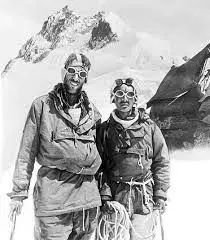Top 10 Interesting Facts about Mount Everest
Mount Everest, the highest mountain on Earth, is like a gigantic challenge waiting to be conquered. It’s so tall that it reaches a whopping 29,032 feet (8,848 meters) above the sea. People from all over the world are drawn to it, looking to test their courage and determination.
Imagine starting your journey at a special camp called Mount Everest Base Camp, which is already way up high at 17,600 feet (5,364 meters). Climbers face tough conditions, like freezing cold and thin air, as they try to reach the very top. There’s a part called the “Death Zone” where the air is so thin that staying there for too long can be really dangerous. Even though climbers celebrate reaching the summit, there’s a downside too – the mountain has been treated like a giant garbage dump, so efforts are being made to clean it up.
Back in 1953, two brave climbers, Sir Edmund Hillary and Tenzing Norgay, were the first to make it to the top. Since then, many have followed in their footsteps, but the mountain still holds risks and challenges. It’s not just about the climb; it’s also about the impact on the environment and the Sherpa people, who have been a crucial part of Everest’s story for a very long time.
So, in this blog, we will delve into the fascinating world of Mount Everest, exploring the top 10 interesting facts that make this iconic peak both a testament to human achievement and a reflection of the delicate balance between nature and exploration. From its towering height to the challenges faced by climbers and the environmental concerns that surround it, Everest’s story is one of triumphs, struggles, and the intricate relationships that shape its legacy. Join us as we uncover the wonders and complexities that define the legendary Mount Everest.
Top 10 Interesting Facts about the Mount Everest
- Tallest Mountain on Earth
- Named After Sir George Everest
- Challenging Climbing Routes
- Growth Rate of the Mountain
- High-Altitude Ecosystems
- First Successful Ascent
- Dangerous “Death Zone”
- Mount Everest Base Camp
- Environmental Concerns
- Sherpas and Climbing Industry
Tallest Mountain on Earth
Mount Everest is the tallest mountain on Earth, standing at a staggering height of 29,032 feet (8,848 meters) above sea level. It is part of the Himalayan mountain range and is located on the border between Nepal and China (Tibet). The mountain’s height is subject to change due to shifting tectonic plates and geological factors.
Named After Sir George Everest
The mountain was named after Sir George Everest, a British surveyor general of India during the 19th century. Interestingly, Sir George Everest objected to having the mountain named after him, as he believed that the local names should be preserved. Despite his objections, the name Mount Everest stuck, and it became internationally recognized.

Challenging Climbing Routes
Mount Everest presents climbers with several challenging routes, but the two main routes are the South Col route in Nepal and the North Col route in Tibet. The South Col route is known for its challenging icefall, steep rock faces, and the infamous Hillary Step, a nearly vertical rock wall. Climbers face extreme weather conditions, altitude sickness, and crevasses, making Everest one of the most difficult mountains to climb.
Growth Rate of the Mountain
Mount Everest is still growing at a rate of approximately 0.04 inches (1.2 centimeters) per year due to the ongoing collision of the Indian and Eurasian tectonic plates. This growth is a result of the Earth’s crust being compressed, causing the Himalayas to rise over time. Despite being the tallest mountain, Everest continues to slowly gain height.
High-Altitude Ecosystems
Mount Everest hosts a variety of high-altitude ecosystems that are adapted to extreme conditions. These include the alpine zone, characterized by sparse vegetation; the subnival zone, where only lichens and mosses can survive; and the snow leopard habitat. The region is also home to unique flora and fauna, such as the Himalayan tahr, red panda, and a variety of alpine plants that have adapted to the harsh climate of the high-altitude environment.
First Successful Ascent
The first successful ascent of Mount Everest was achieved by Sir Edmund Hillary from New Zealand and Tenzing Norgay, a Sherpa of Nepal, on May 29, 1953. Their historic climb was part of a British expedition led by Colonel John Hunt. Since then, climbing Everest has become a significant accomplishment and a goal for many mountaineers worldwide.

Dangerous “Death Zone”
The altitude above 26,247 feet (8,000 meters) on Mount Everest is commonly referred to as the “Death Zone.” In this thin air, there is not enough oxygen to sustain human life for an extended period, and climbers are at an increased risk of altitude sickness, hypothermia, and other life-threatening conditions. Despite the risks, climbers often spend limited time in the Death Zone to reach the summit.
Mount Everest Base Camp
The journey to Everest’s summit typically begins at the Mount Everest Base Camp (EBC), situated at an altitude of approximately 17,600 feet (5,364 meters). The base camp serves as a crucial acclimatization point for climbers and a logistical hub for various expeditions. It provides stunning views of the Khumbu Icefall, the first major obstacle on the South Col route.
Everest Base Camp is also the most popular trekking destination in the world. For those unable to ascend the towering Mount Everest, many opt for the Everest Base Camp trek. This journey provides a breathtaking perspective of the majestic Mount Everest, offering a captivating and awe-inspiring experience for trekkers.
Environmental Concerns
Mount Everest faces environmental challenges, including the accumulation of garbage left behind by climbers. The mountain is often referred to as the “world’s highest garbage dump.” In recent years, efforts have been made to address this issue, with clean-up initiatives organized to remove tons of waste, including discarded oxygen cylinders, tents, and other debris.
Sherpas and Climbing Industry
The Sherpa people, native to the Everest region, have played a crucial role in supporting mountaineering expeditions. Sherpas serve as guides, porters, and support staff for climbers attempting to summit Everest. The climbing industry has significantly impacted the local economy, but it has also raised concerns about the exploitation and safety of Sherpa workers. Efforts are ongoing to address these issues and ensure fair treatment for the Sherpa community.



